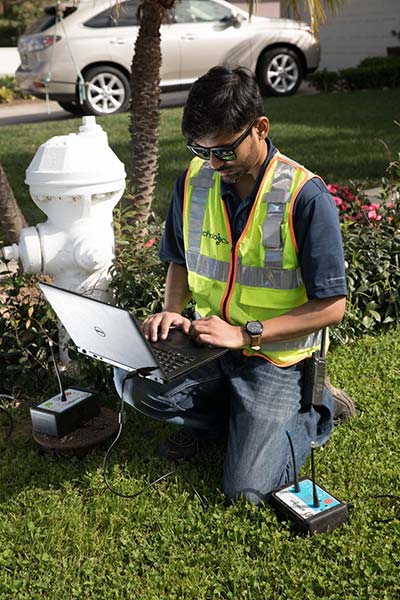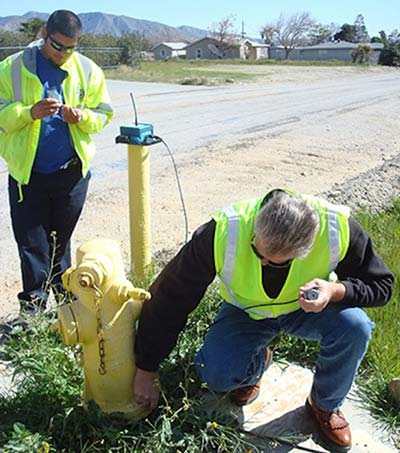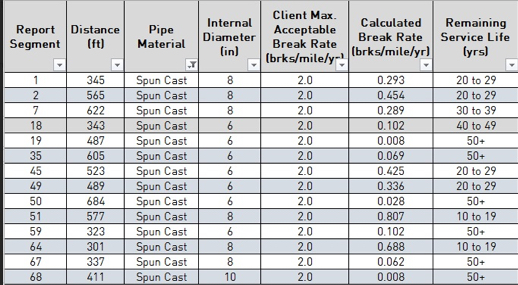Sooner or later, every water distribution system leaks, both in remote rural areas as well as dense urban cities. The consequences of a pipeline leaking in a forest, forming a small stream that appears to be part of the natural surroundings, may not necessarily justify the need for leak detection systems in remote areas. However, permanent leak monitoring in high density areas can reduce the disastrous impacts of pipe bursts which trigger a tsunami of costs far beyond the expense of the pipeline repair alone.
The key is being prepared, to minimise the costs and complications related to those leaks. This starts with mapping the utilities water distribution system using a solid Geographic Information System (GIS), and then adding important details such as pipelines, including material, age and burst frequency. By using a GIS system, the utility can then develop a plan for managing its pipelines, which would include pipe rehabilitation, pipe replacement, pressure management and leak detection activities.

Prepare For The Inevitable
There are two basic leak-detection strategies to take — periodic surveys(ad hoc or scheduled) and permanently installed monitoring solutions— but a combination of the two is what works best. A periodic survey will reveal active leaks, but it cannot tell exactly how long a leak has been active. As a result, there is no accurate way to quantify the volume and subsequent cost of the water lost. By contrast, a permanently installed monitoring system can track the progression of a leak, from the moment it first appears, allowing a utility to allocate resources based on priority of leak size and progression speed.
The extent of a survey programme often depends on the size and scope of the water utility. Smaller utilities can assess their entire systems in a matter of days. A larger utility will typically conduct condition assessments and periodic surveys on a rolling basis (Figure 1). This can often mean that some pipelines are only surveyed once every year or two.
Surveys are often prioritised around existing desktop hydraulic simulation models, based on the oldest sections of infrastructure (Figure 2), or on zones with the highest break rates. But this can still lead to teams surveying hundreds of kilometres to find just a handful of leaks. If a utility has a permanent monitoring system installed across broad swaths of the system, they can use real time data to direct survey crews to pinpoint leaks as they form.

Portable acoustic equipment deployed on an ad hoc basis is used to survey targeted pipeline segments for leaks
A Tenuous Connection
To demonstrate both how sensitive and elusive leak detection can be, Brandon Jacobs, an Echologics® field project manager for Mueller Water Products relates a story from the West Coast U.S. where the utility was dealing with a variety of water main breaks and smaller failures, aggravated by pockets of corrosive soils. “We detected a water main leak in an area where an emergency leak repair had been performed just a few days prior,” Jacobs recalls. “When we first got there, we had a tough time pinpointing the leak, because a home about 30 metres away had a water heater leak where the constantly spinning water meter put out a louder sound than the water main leak.” Once the homeowner shut off the water through the meter, the engineer was able to locate the actual water main leak, but that was not the end of the story.
“A couple of days later, a repair crew went out to fix the water main leak we had pinpointed,” he relates. “They excavated dry dirt with a backhoe down to the point where they had cleared enough space to work. A worker went down into the pit as soon as wet dirt appeared, so he could hand-shovel enough space to install a full-circle repair clamp on the main. As he dug down, he found a piece of wood used as a shim to level the pipe during installation. He hit the shim to remove it, and suddenly this hole started filling up with water and a river of mud started running down the street.”
Once the water main was shut off and the pipe inspected, the crew understood exactly what had happened. The wooden shim was supporting a 15 cm flap of pipe attached by roughly 1 cm of solid material at one end and surrounded by a series of corrosion pits that essentially created one big crescent shape. The flap blew out when the shim was removed. Despite the brief deluge, everyone recognised the value of catching that condition in its infancy. “They essentially took what was a 3.7-lpm leak and created an 1,892-lpm leak in seconds,” Jacobs says. “Can you imagine the problems there would have been if that flap had given way in the middle of the night when no one was around to react?”

Figure 1. Detailed pipeline assessment surveys generate statistical input that can be used to generate reasonable estimates of remaining service life, by pipeline segment, to help utilities prioritise pipe replacement schedules
If A Pipe Leaks In A Forest…
An example of the value routine pipeline assessment provides for discovering “hidden” leaks comes from an Echologics experience with an 80-year-old, 122 cm steel pipeline that ran across an entire county — downtown city centres, suburban countryside and heavily wooded forests. “We detected a big spike right in the middle of a section between two chambers we were evaluating in the thickest woodland,” Jacobs explains. “We knew there was another chamber half way between the two points we were testing, and thought that might be the location. We started bushwhacking, crossed a creek and fought our way uphill toward the third chamber we knew was located between our test locations. When we got there, we discovered an air valve inside the chamber had completely rusted off and fallen off the pipe. That was when we realised that the “creek” we crossed to get there was the leak from this water main, running down the hill through the forest.”
Beat the Leak: Plan Ahead
New leaks form continually. The only way to get ahead is to work faster (and smarter) than the leaks. Echologics® EchoShore® leak detection technology from Mueller Water Products uses mobile data transmission and remove the restrictions of distance associated with radio communications between sensors. Multiple sensors deployed along a main are remotely triggered to synchronise and capture data. The data is automatically transmitted to the cloud platform where it undergoes a multi-staged automatic analysis, breaking down the various dimensions of the data, and analysing for potential points of interest. All this can be achieved in a matter of minutes.
The resulting benefit to the user is high speed accurate analytics for leak detection crew to make informed recommendations to best allocate repair crew. Multiple sensors working simultaneously over large distances, instant and timed remote triggering of recordings, and automatic deep data analysis are all completed within minutes. These powerful factors combine to allow rapid progress to be made each day, saving more water and reducing the cost of each leak found. EchoShore technology can analyse thousands of kilometres of pipe per year, helping utilities save millions of litres per day. WWA
About the Author: Gary Wyeth is SE Asia Regional Account Manager for Mueller Water Products with over 25 years of experience in the water industry, primarily in South-East Asia. He is a member of the Chartered Institution of Water & Environmental Management and the IWA Water Loss Specialist Group.
Click here to read the article in Water & Wastewater Asia
